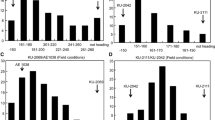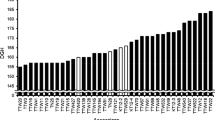Abstract
A novel photoperiod response gene, designated Ppd-B2, was mapped to wheat chromosome arm 7BS, using a set of lines carrying various segments of 7BS from the early flowering breeding line ‘F26-70 7B’ in a background of the variety ‘Favorit’. The gene was 4.4 cM distal of the microsatellite locus Xgwm0537 and 20.7 cM proximal to Xgwm0255. In contrast to the well-characterized Ppd-1 genes, which require short days for expression, Ppd-B2 was detected when plants were exposed to a long photoperiod. The accelerated flowering produced by Ppd-B2 was correlated with increased grain protein content.




Similar content being viewed by others
References
Avsenin VI, Stelmakh AF (1989) Genetic control of growth habit of spring cultivar Hope. In: Abstr report conf “Special genetics of plants”, Kiev, 23–25 May 1989, vol 1, 3 pp
Barneix AJ, Fatta N, Kade M, Pfluger L, Suarez EY (1998) Effect of wheat chromosome 7BS on grain protein concentration. EWAC Newsl (Proc 10th EWAC conf, 1997, Viterbo, Italy) 10:13–16
Blanco A, Pasqualone A, Troccoli A, Di Fonzo N, Simeone R (2002) Detection of grain protein content QTLs across environments in tetraploid wheats. Plant Mol Biol 48:615–623. doi:10.1023/A:1014864230933
Börner A, Buck-Sorlin GH, Hayes PM, Malyshev S, Korzun V (2002) Molecular mapping of major genes and quantitative trait loci determining flowering time in response to photoperiod in barley. Plant Breed 121:129–132. doi:10.1046/j.1439-0523.2002.00691.x
Ganal M, Röder MS (2007) Microsatellite and SNP markers in wheat breeding. In: Varshney RK, Tuberosa R (eds) Genomics-assisted crop improvement. Vol. 2: genomics applications in crops. Springer, The Netherlands, pp 1–24
Gervais L, Dedryver F, Morlais JY, Bodusseau V, Negre S, Bilous M et al (2003) Mapping of quantitative trait loci for field resistance to Fusarium head blight in an European winter wheat. Theor Appl Genet 106:961–970
Giura A (2003) Genetic effect of chromosome 7B on some quality traits and earliness in wheat. Cercetări ştiinţifice. Seria VII-a, Biotehnologie şi Biodiversitate (Edit. Agroprint, Timişoara, 2003), pp 271–279
Giura A, Ittu G (1986) Genetic analysis of protein content in the wheat line F26-70 using whole chromosome substitutions. Cereal Res Commun 14:5–10
Giura A, Ittu G, Oproiu E (1986) Genetic analysis of protein content and some bread making characteristic in the wheat line F26-70 (in Romanian, English summary). Probleme de genetică teoretică şi aplicată XVIII(2):83–93
Goncharov NP (2002) Classification of genus Tritium L. In: Shumny VK (ed) Comparative genetics of wheats and their related species. Siberian University Press, Novosibirsk, pp 1–252
Goncharov NP, Gaidalenok RF (1994) Role of chromosomes of wheat homoeologous group 7 in growth habit control. Russ J Genet 30:1071–1074
Groos C, Robert N, Bervas E, Charmet C (2003) Genetic analysis of grain protein-content, grain yield and thousand-kernel weight in bread wheat. Theor Appl Genet 106:1032–1040
Halloran GM (1976) Genes for vernalization response in homoeologous group 5 of Triticum aestivum. Can J Genet Cytol 18:211–216
Hoogendoorn J (1985) A reciprocal F1 monosomic of the genetic control of time of ear emergence, number of leaves and spikelets in wheat (Triticum aestivum L.). Euphytica 34:545–558. doi:10.1007/BF00022954
Khlestkina EK, Pestsova EG, Röder MS, Börner A (2002) Molecular mapping, phenotypic expression and geographical distribution of genes determining anthocyanin pigmentation of coleoptiles in wheat (Triticum aestivum L.). Theor Appl Genet 104:632–637. doi:10.1007/s00122-001-0788-x
Khlestkina EK, Pshenichnikova TA, Röder MS, Arbuzova VS, Salina EA, Börner A (2006) Comparative mapping of genes for glume colouration and pubescence in hexaploid wheat (Triticum aestivum L.). Theor Appl Genet 113:801–807. doi:10.1007/s00122-006-0331-1
Khlestkina EK, Röder MS, Pshenichnikova TA, Simonov AV, Salina EA, Börner A (2008) Genes for anthocyanin pigmentation in wheat: review and microsatellite-based mapping. In: Verrity JF, Abbington LE (eds) Chromosome mapping research developments. NOVA Science Publishers, Inc, New York, USA, pp 155–175
Konzak FC (1977) Genetic control of the content, amino acid composition and processing properties of proteins in wheat. Adv Genet 19:408–582
Kuchel H, Hollamby G, Langridge P, Williams K, Jefferies SP (2006) Identification of genetic loci associated with ear-emergence in bread wheat. Theor Appl Genet 113:1103–1112. doi:10.1007/s00122-006-0370-7
Lander ES, Green P, Abrahamson J, Barlow A, Daly MJ, Lincoln SE et al (1987) MAPMAKER: an interactive computer package for constructing primary genetic linkage maps of experimental and natural populations. Genomics 1:174–181. doi:10.1016/0888-7543(87)90010-3
Laurie DA, Pratchett N, Bezant JH, Snape JW (1995) RFLP mapping of five major genes and eight quantitative trait loci controlling flowering time in a winter × spring barley (Hordeum vulgare L.) cross. Genome 38:575–585
Law CN (1966) The location of genetic factors affecting a quantitative character in wheat. Genetics 53:487–498
Law CN, Wolfe MS (1966) Location of genetic factors for mildew resistance and ear emergence time on chromosome 7B of wheat. Can J Genet Cytol 8:462–470
Law CN, Worland AJ, Giorgi B (1976) The genetic control of ear emergence time by chromosomes 5A and 5D of wheat. Heredity 36:49–58. doi:10.1038/hdy.1976.5
Law CN, Sutka J, Worland AJ (1978) A genetic study of day-length response in wheat. Heredity 41:185–191. doi:10.1038/hdy.1978.87
McIntosh RA, Yamazak Y, Devos KM, Dubcovsky J, Rogers J, Appels R (2003) Catalogue of gene symbols for wheat. http://www.grs.nig.ac.jp/wheat/komugi/genes/
Miura H, Worland AJ (1994) Genetic control of vernalization, day length response, and earliness per se by homoeologous group-3 chromosomes in wheat. Plant Breed 113:160–169. doi:10.1111/j.1439-0523.1994.tb00718.x
Nelson JC (1997) QGENE: software for mapmaker-based genomic analysis and breeding. Mol Breed 3:239–245. doi:10.1023/A:1009604312050
Plaschke J, Ganal MW, Röder MS (1995) Detection of genetic diversity in closely related bread wheat using microsatellite markers. Theor Appl Genet 91:1001–1007. doi:10.1007/BF00223912
Röder MS, Korzun V, Wendehake K, Plaschke J, Tixier M-H, Leroy P et al (1998) A microsatellite map of wheat. Genetics 149:2007–2023
Salina E, Börner A, Leonova I, Korzun V, Laikova L, Maystrenko O et al (2000) Microsatellite mapping of the induced sphaerococcoid mutation genes in Triticum aestivum. Theor Appl Genet 100:686–689. doi:10.1007/s001220051340
Snape JW, Semikhodskii A, Sarma R, Korzun V, Fish L, Quarrie SA et al (1998) Mapping vernalization loci in wheat and comparative mapping with other cereals. In: Slinkard AE (ed) Proc 9th intern wheat genet symp, vol 3. University Extension Press, Saskatoon, Saskatchewan, Canada, pp 156–158
Snape JW, Butterworth K, Whitechurch E, Worland AJ (2001) Waiting for fine times: genetics of flowering time in wheat. Euphytica 119:185–190. doi:10.1023/A:1017594422176
Sourdille P, Perretant MR, Charmet G, Cadalen T, Tixier MH, Joudrier P et al (1999) Detection of QTL for bread making quality in wheat using molecular markers. In: Scarascia Mugnozza GT, Porceddu E, Pagnotta MA (eds) Genetics and breeding for crop quality and resistance. Kluwer Academic Publishers, Dordrecht, Netherlands, pp 361–366
Sourdille P, Snape JW, Cadalen T, Charmet G, Nakata N, Bernard S et al (2000) Detection of QTLs for heading time and photoperiod response in wheat using a doubled-haploid population. Genome 43:487–494. doi:10.1139/gen-43-3-487
Welsh JR, Keim DL, Pirasteh B, Richards RD (1973) Genetic control of photoperiod response in wheat. In: Sears ER, Sears LMS (eds) Proc 4th intern wheat genet symp. University of Missouri Experiment Station, Missouri, USA, pp 879–884
Yan L, Fu D, Li C, Blechl A, Tranquilli G, Bonafede M et al (2006) The wheat and barley vernalization gene VRN3 is an orthologue of FT. Proc Natl Acad Sci USA 103:19581–19586. doi:10.1073/pnas.0607142103
Acknowledgements
The first author thanks the Russian Foundation for Basic Research (08-04-00368-a), SB RAS (Complex Integration Project No 5.8), the Russian Science Support Foundation, Timofeeff-Ressovsky Scientific Society “Biosphere and Mankind” and a grant from the President of the Russian Federation (project No MK-566.2007.4) for financial support, and Renate Voss for excellent technical assistance.
Author information
Authors and Affiliations
Corresponding author
Rights and permissions
About this article
Cite this article
Khlestkina, E.K., Giura, A., Röder, M.S. et al. A new gene controlling the flowering response to photoperiod in wheat. Euphytica 165, 579–585 (2009). https://doi.org/10.1007/s10681-008-9783-5
Received:
Accepted:
Published:
Issue Date:
DOI: https://doi.org/10.1007/s10681-008-9783-5




